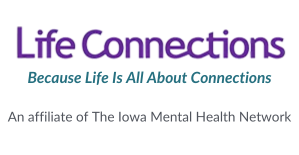When it comes to disciplining children, there are a few autopilot responses that parents often default to including spanking and time outs. No-Drama Discipline authors Dr. Daniel Siegel, M.D. and Tina Payne Bryson, PhD address two parenting strategies and why some strategies have poorer outcomes than other methods. Life Connections School-Based Therapist, Jada Mathison, MS, tLMHC, will discuss this resource and explain how to build attachment with children to aid in effective discipline. Please note, discipline means to teach, not punish.
Spanking
Research on spanking shows that even when warm and nurturing parents utilize spanking as a discipline strategy, the long term outcomes for a change in behavior is low and these children are at a greater risk for negative outcomes overall when it comes to mental health. Spanking can also be detrimental to the parent-child relationship as the child’s attention shifts from modifying their own behavior to only addressing their parent’s response. The child no longer considers their own behavior and instead focuses on the scare factor of this style of discipline thus undermining the goal: To encourage the child to think about and change their behavior.
Children are born with the instinct to move towards their caregiver when in distress, but when their caregiver is also the source of their pain and fear, they are placed in a conflicting position; to escape their caregiver or to move towards their caregiver (the source of their pain and fear), for comfort. This confusion can lead to the release of stress hormones which can be toxic and impede brain growth. Spanking and the infliction of physical pain is also said to engage the fight, flight, and freeze responses in the more primitive part of the brain. When this occurs, the child is actively working against the part of their brain responsible for cognitive thought and learning which is counterproductive in changing behavior.
Timeouts
In the contrary, effective time outs have been shown to reduce child abuse and are safer for children than spanking. Effective time outs are defined as: “A brief period of three to five minutes that pauses a difficult interaction.” This style of discipline has been discussed with the child beforehand, and is most effective when used infrequently. When used in this way, time outs assist children in learning how to self-regulate and uncover the underlying lesson.
However, when caregivers overuse this style of discipline, children tend to associate time outs with humiliation and punishment leading to an increase in dysregulation and anger. Instead of thinking about their behaviors and calming down, children are consumed by how ‘unfair’ and ‘mean’ their caregivers are. It is important to remember that behaviors are children’s attempt to express a need. By isolating them consistently when they express this need, we send a message, “I will be in a relationship with you when you are ‘good’ or ‘happy’, but will withhold love and affection when you are not.”
What Is Your Discipline Philosophy?
Here are some questions to ask yourself about the way in which you discipline a child:
- Do I have a discipline philosophy? How purposeful and consistent am I when my child misbehaves?
- Is what I am doing working? Does my approach allow me to teach my kids the lessons I want to teach?
- Do I feel good about what I am doing? Does my discipline approach help me enjoy my relationship with my children?
- Do my children feel good about it? Do my children understand my approach and feel my love? Am I communicating and modeling respect?
- Do I feel good about the message that I am communicating?
- How much does my approach resemble that of my own parents? How did I feel when they used these discipline strategies?
- Does my approach ever lead to my kids apologizing in a sincere manner even though it may not happen on a consistent basis?
- Does it allow me to take responsibility for my actions and apologize for my own actions? How open am I with my kids when I make mistakes?
Connection to Regulate and Build Healthy Attachment
- Connect with comfort.
The most powerful nonverbal response you can give your child is touch. When we touch our children whether it be a hug, rubbing of their back, or squeezing their hand, it releases ‘feel good’ hormones in our brains and stress hormones decrease. We can further communicate comfort by placing ourselves in a non-threatening position and lowering ourselves to or below their eye level. - Validate.
We can connect with our children by validating their perceived experiences and feelings. Think about what you would like to hear when you have big feelings. Do you want to hear “there is nothing to get upset about,” or “I can see that you are really upset?” Help them identify the feelings that they are experiencing. By validating our child’s experience, we communicate that we will always be there for them no matter their emotional state. - Stop talking and listen.
Talking at and talking to an emotionally charged child is not effective. When in this state, their brain is not capable of receiving messages and learning from them. - Reflect what you hear.
By reflecting what we hear, we are telling the child that you understand their experience. In this step, we offer perspective to their experience such as, “I don’t blame you. I hate it when people tease me like that, too. I know that you love your friends and you were just having so much fun, and now you’re really mad at them, aren’t you?” We summarize what happens in a way that assists the child in identifying their feelings while also not letting them get stuck in the thought, “I hate them.”After we connect with the child, we can then address the behavior, give alternatives, and provide the lesson that we want to teach.
For additional parenting information based on brain science, check out No-Drama Discipline: The Whole Brain Way to Calm the Chaos and Nurture Your Child’s Developing Mind by Daniel Siegel, M.D. and Tina Payne Bryson, PhD.
Jada Mathison, MS, tLMHC
School-Based Therapist
Because Life is All About Connections
Life Connections provides in-home Behavioral Health Intervention services, Therapy services, autism (ABA) services and Children’s Mental Health waiver services in our 13 office locations and approved schools across Iowa. Life Connections was founded in March of 2009 with the intent to serve the children and families of Cedar Rapids and surrounding cities.
Life Connections is a highly professional and caring counseling and behavioral health provider. We offer a wide array of services to treat mental health issues including Applied Behavior Analysis Services, Behavioral Health Intervention Services, mental health therapy, school-based therapy programs, and substance use treatment.
For more information, please call 319-409-6922.
Resources:
- National Suicide Prevention Hotline 800-273-8255
- Crisis Text line text to 741741
- The Trevor Project – for LGBTQ+ young adult community 866-488-7386
- Rape, Abuse, and Incest National Network 800-656-4673
Start Your Services
Start Mental & Behavioral Health Services with Life Connections | Because life is all about connections.

